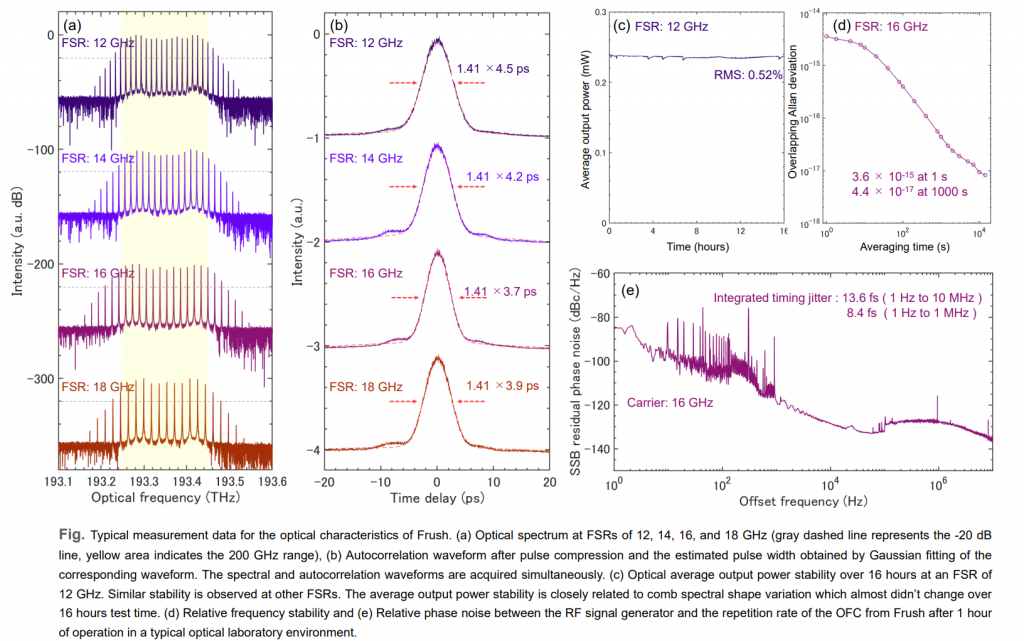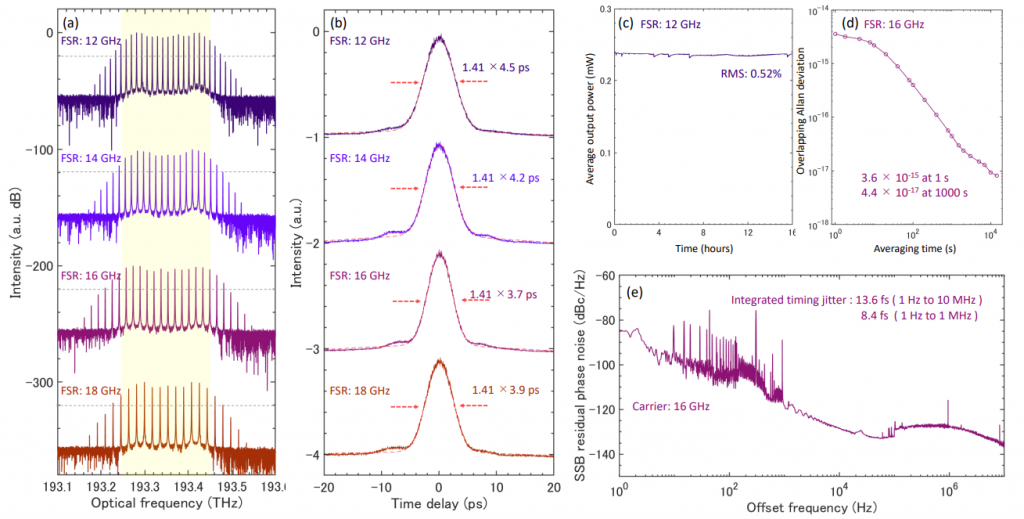Overview
Our optical frequency comb generator, Frush, generates an optical frequency comb with a flat optical spectrum in a free spectral range (FSR) of 12-18 GHz using a single LN modulator. Typically, this optical frequency comb takes the form of a picosecond optical pulse with a repetition frequency corresponding to the FSR. Frush alone cannot generate the optical frequency comb; it requires an external continuous wave (CW) light source and an RF signal generator.
The linewidth of each longitudinal mode in the generated optical frequency comb and the average power obtained by summing these longitudinal modes depend on the CW light source. The average output power of the optical frequency comb is attenuated by approximately 20 dB compared to the average output power of the CW light source. We recommend using an external CW light source with a linewidth of less than 3 MHz, average output power of more than 13 dBm, and polarization-maintaining fiber (PMF) output from a distributed feedback (DFB) laser.
The timing jitter of the picosecond optical pulses depends on the phase noise of the RF signal generator. The external RF signal source should be capable of outputting a sine wave with a frequency corresponding to the FSR of the optical frequency comb, with a power level of around +20 dBm.
Key Features
- 12-18 GHz channel spacing
- Flat Spectrum
- Optical monitor output port×1
- RF monitor output port×2
- Seed Light Source/RF Signal External Input
Applications
- Gas Sensing
- Millimeter-wave/THz wave oscillation and reception
- Ultrafast spectroscopy and high-resolution spectroscopy
- optical communication
- Distance measurement (LIDAR) and 3D shape measurement,
Niigata University Prof. Choi’s paper using “Frush” is here▼
Samuel Choi, Takeru Ota, Fumiaki Nin, Tatsutoshi Shioda, Takamasa Suzuki, and Hiroshi Hibino, “Rapid optical tomographic vibrometry using a swept multi-gigahertz comb,” Opt. Express 29, 16749-16768 (2021)
Specifications
- Center wavelength: Near 1550nm
- Spectral Width: 3nm
- Optical average output: > -5 dBm at 13 dBm optical input
- Optical pulse width: < 5ps
- Comb spacing: 12-18GHz (variable)
- Output port: FC/APC
- Polarization: Linearly polarization is possible (recommended)
- Power supply voltage: 100VAC
- Size:148(H)×480(W)×430(D) mm
The front panel of the chassis has one port for optical signal monitoring output, and the rear panel has two ports for RF signal monitoring output, enabling synchronization with measurement instruments. The pulsed optical frequency comb output from “Frush” can be amplified to around +33 dBm using an optical fiber amplifier, and then input into a highly nonlinear optical fiber to broaden the spectral width to several tens of nanometers through self-phase modulation.
■ Usage example


Product Explainer Video
A demonstration video of “Frush” (English ver.)
This 2-minute video shows the setup equipment and the generation of an optical frequency comb.
Optical frequency comb 『Frush』 Characterization of noise performance (English ver.)
We have measured various noise of the optical frequency comb generated by Frush. Phase noise, average optical power fluctuation, optical spectral shape fluctuation. Frush has suitable noise performances for almost every application.
Research Papers
- Optical Comb Product Development for Measurement Research, Optical November 2019 Issue Explanatory Article
- Highly flexible for a wide range of applications EO-comb, Optics & Photonics Japan 2019 Invited Talk



